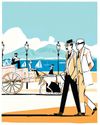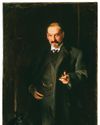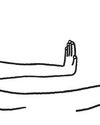
Alexei Ratmansky’s new ballet, “Solitude,” which recently premièred at New York City Ballet, begins with a devastating image: a father holding his dead son’s hand. The dance is dedicated to “the children of Ukraine, victims of war,” and Ratmansky has said that this image comes from a photograph of a father in Kharkiv sitting on the ground at a bus stop with his child, killed in a Russian air strike. This is Ratmansky’s second dance alluding to the war, but there is nothing outwardly political about it. The dancing is abstract and classically based, with no narrative and few outward signs of violence and death. Ratmansky’s canvas is not war but the human mind, and what he has managed to stage, with fourteen dancers and one child, is the disorienting experience of grief.
The opening tableau, sculptural in composition, brings to mind the war-scarred art of Käthe Kollwitz. The man kneels silently in a corner of an empty stage, eyes blankly staring into semidarkness. The lifeless boy whose hand he holds lies on his back in a bright-blue T-shirt, his face turned away from us, toward the father. We see everything; they see nothing. No one moves. The figures are presented without anything that might suggest their whereabouts or their lives. We could be them, and the sight is etched into our minds before the music begins and the lights rise.
This story is from the March 11, 2024 edition of The New Yorker.
Start your 7-day Magzter GOLD free trial to access thousands of curated premium stories, and 9,000+ magazines and newspapers.
Already a subscriber ? Sign In
This story is from the March 11, 2024 edition of The New Yorker.
Start your 7-day Magzter GOLD free trial to access thousands of curated premium stories, and 9,000+ magazines and newspapers.
Already a subscriber? Sign In

BADDIE ISSUES
\"Wicked\" and \"Gladiator II.\"

LET'S MAKE A DEAL
\"Death Becomes Her\" and \"Burnout Paradise.\"

ANTI HEROES
\"The Franchise,\" on HBO.

FELLOW-TRAVELLERS
The surprisingly sunny origins of the Frankfurt School.

NOW YOU SEE ME
John Singer Sargent's strange, slippery portraits of an art dealer's family.

PARIS FRIEND - SHUANG XUETAO
Xiaoguo had a terror of thirst, so he kept a glass of water on the table beside his hospital bed. As soon as it was empty, he asked me to refill it. I wanted to warn him that this was unhealthy - guzzling water all night long puts pressure on the kidneys, and pissing that much couldn't be good for his injury. He was tall, though, so I decided his insides could probably cope.

WILD SIDE
Is Lake Tahoe's bear boom getting out of hand?

GETTING A GRIP
Robots learn to use their hands.

WITHHOLDING SEX FROM MY WIFE
In the wake of [the] election, progressive women, who are outraged over Donald Trump's victory at the ballot box, have taken to social media with public, vengeful vows of chastity. - The Free Press.

DEADLINE EXTENSION
Old age, reborn.